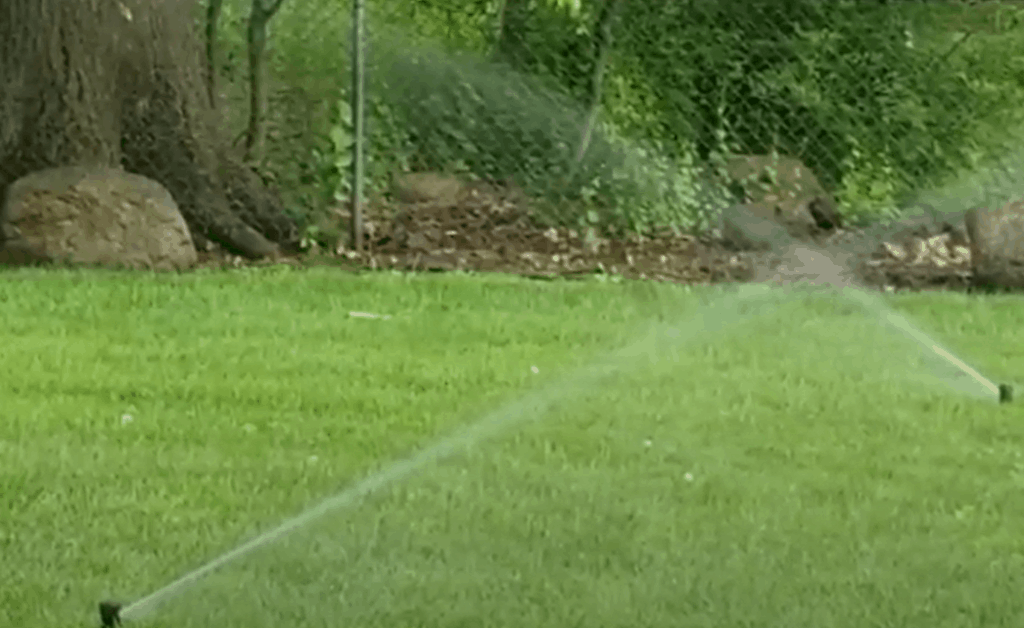
Upon opening my sprinkler system this Spring I noticed that one zone in my system looked weak in its stream. I took a quick look and found a percolating water spring running out onto my lawn causing a small puddle. I leaked. As it turns out, it was caused by the sprinkler hose being too shallowly buried and an unlucky pass with my aerator. Pop!
While unfortunate at the moment, it is also a grand opportunity to show those who have never attempted this type of fix on their own before, how easily this repair can be performed.
I made a video showing most of the necessary actions and tools with which to accomplish this task quickly, easily, and inexpensively as compared to having to hire a pro. According to Angie’s List, this repair would normally cost between $130 and $385 to hire a professional to do this for you.
That’s a lot of money and, as I had mentioned, this will likely happen again somewhere else on the property. I, myself found it to be decidedly worth the attempt at a new skill. If it worked out for me, it will for you too. With this said, there are a couple of out-of-the-ordinary, inexpensive tools that you will need to acquire.
Specific Tools:
- a PVC pipe cutter – cost: between $15 and $20 (a good investment going forward)
- Bernz-o-Matic TS4000 torch head – cost: between $45 and $50 (also a good investment going forward)
- If you need fuel, Bernzomatic offers propane canisters – cost: between $3 and $5
It is important to mention that when purchasing this torch you also get the propane fuel. DO NOT purchase the Map fuel (Yellow Canister). Map fuel is expensive and it burns too hot for this type of work. The propane distributed by Bernzomatic will be in a blue-colored canister.
Beyond the tools you will also need some materials:
- 3/4″ Sprinkler hose line – cost: ~$20 per 100′ (for this particular job, if you’re careful, you won’t need any extra hose)
- 3/4″ Sprinkler hose coupling(s) – cost: ~ $1 (this is a definite necessity)
- 3/4″ Hose Clamps -cost ~ $1.25 ea (at least 2 for the repair illustrated in this article)
The total cost of the repair that we will accomplish here will come to between $65 and $77, as opposed to $130 and $385. That’s, at least, a $65 savings on this repair alone (more if there is sales tax involved) along with a big boost in the pride of skill development (priceless).
The standard Berzomatic torch that most folks will have around the house is a “good to have” product. But, it won’t be of good use with this project. For this job, the flame must be regulated to keep burning even when the torch is tilted in a downward direction. Otherwise, the flame will extinguish itself before you can apply the flame. Hence the TS4000 torch head.
Please feel free to watch the below video that I have put together for you to guide you through this repair…
So, let’s get this started…
Step 1 – Locate the Leak
Find the leak – It is not likely that you will find your leak spewing water like a geyser, though it does happen, especially if the hole is smaller – counter-intuitive? Most of the time you will see a zone putting out a weak stream of water from every sprinkler head. It is at this point that you will have to hunt the leak down. You will usually find, as I did here, a puddle forming with some percolation from underground. When you find it, mark it with a rock or whatever you may have handy.
Step 2 – Excavate the Leak
Excavate the leak – You will have to dig out the area around the leak. Generally, I find that a garden trowel will do just fine but there are occasions when you will need a flat shovel.
I once had a leak that had two small perforations about a foot or so apart and had to use the shovel to expose both leaks. This sort of fix is not different than what we are covering here. It will however involve more couplings, hose clamps, and sprinkler hose.
– Steps 3 – 6 are addressed in the accompanying video below –
Step 3 – Cut out the Leaking Hose Segment
Once the leak is found and excavated, you will need to cut a segment of the hose that encompasses the hole, out of the house – about 1/2″ wide. We do this to accommodate the space in the middle of the coupling.
Step 4 – Place the Hose Clamps – very important
Before you do anything else, make certain that you place hose clamps on either side of the segmented hose to be able to secure the hose to the ends of the coupling.
Step 5 – Check that the Coupling Fits Properly
Check to see that the coupling fits the space properly; with all barbs inside their respective hose ends.
Step 6 – Apply Heat to the Hose Line
As per the video above, heat one end of the hose line gently, being careful not to melt the end of the hose. Then, immediately, but carefully insert the coupling into the hose where the barbs are inside the hose.
If it’s your first time using a torch, approach the situation with patience, care and confidence. Here is an attending video on how to use a torch, its benefit over the standard torch head, as well the proper way to use a PVC pipe cutter:
Heat the other segment of the hose, gently, lift the two ends of the hoses slightly (one with the coupling and the other at the same time and insert the other end of the coupling inside the open segment of the sprinkler hose.
Step 7 – Tighten the Hose Clamps
Tighten the hose clamps around the two ends of the hose, on opposite sides of the coupling
Step 8 – Test for Leaks
Test for leaks by turning on the affected sprinkler zone you are working on. If you find one, though unlikely, tighten the clamp just a bit more until the leak stops.
If the leak doesn’t stop, shut off the water and redo the process. At this point, you may need the extra sprinkler hose line and even another coupling if the hose was damaged during the work.
Step 9 – Bury the Repair
Use the excavated soil to re-bury the repaired segment of hose down to at least the depth it was found and probably a little deeper to ensure that this will not happen again in this spot.
Nowhere along this path is there going to be an emergency. If you have trouble, approach it with patience and all of this will work out as it should.
Best of Luck to You
Berk
